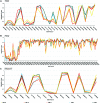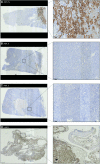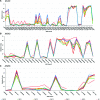Tuberous sclerosis complex: a complex case
- PMID: 35483879
- PMCID: PMC9059781
- DOI: 10.1101/mcs.a006182
Tuberous sclerosis complex: a complex case
Abstract
Tuberous sclerosis complex (TSC) is an inheritable disorder characterized by the formation of benign yet disorganized tumors in multiple organ systems. Germline mutations in the TSC1 (hamartin) or more frequently TSC2 (tuberin) genes are causative for TSC. The malignant manifestations of TSC, pulmonary lymphangioleiomyomatosis (LAM) and renal angiomyolipoma (AML), may also occur as independent sporadic perivascular epithelial cell tumor (PEComa) characterized by somatic TSC2 mutations. Thus, discerning TSC from the copresentation of sporadic LAM and sporadic AML may be obscured in TSC patients lacking additional features. In this report, we present a case study on a single patient initially reported to have sporadic LAM and a mucinous duodenal adenocarcinoma deficient in DNA mismatch repair proteins. Moreover, the patient had a history of Wilms' tumor, which was reclassified as AML following the LAM diagnosis. Therefore, we investigated the origins and relatedness of these tumors. Using germline whole-genome sequencing, we identified a premature truncation in one of the patient's TSC2 alleles. Using immunohistochemistry, loss of tuberin expression was observed in AML and LAM tissue. However, no evidence of a somatic loss of heterozygosity or DNA methylation epimutations was observed at the TSC2 locus, suggesting alternate mechanisms may contribute to loss of the tumor suppressor protein. In the mucinous duodenal adenocarcinoma, no causative mutations were found in the DNA mismatch repair genes MLH1, MSH2, MSH6, or PMS2 Rather, clonal deconvolution analyses were used to identify mutations contributing to pathogenesis. This report highlights both the utility of using multiple sequencing techniques and the complexity of interpreting the data in a clinical context.
Keywords: duodenal carcinoma; pulmonary lymphangiomyomatosis; renal angiomyolipoma.
© 2022 Powell et al.; Published by Cold Spring Harbor Laboratory Press.
Figures








References
-
- Binder ZA, Thorne AH, Bakas S, Wileyto EP, Bilello M, Akbari H, Rathore S, Ha SM, Zhang L, Ferguson CJ, et al. 2018. Epidermal growth factor receptor extracellular domain mutations in glioblastoma present opportunities for clinical imaging and therapeutic development. Cancer Cell 34: 163–177.e7. 10.1016/j.ccell.2018.06.006 - DOI - PMC - PubMed
Publication types
MeSH terms
Substances
LinkOut - more resources
Full Text Sources
Medical
Miscellaneous
